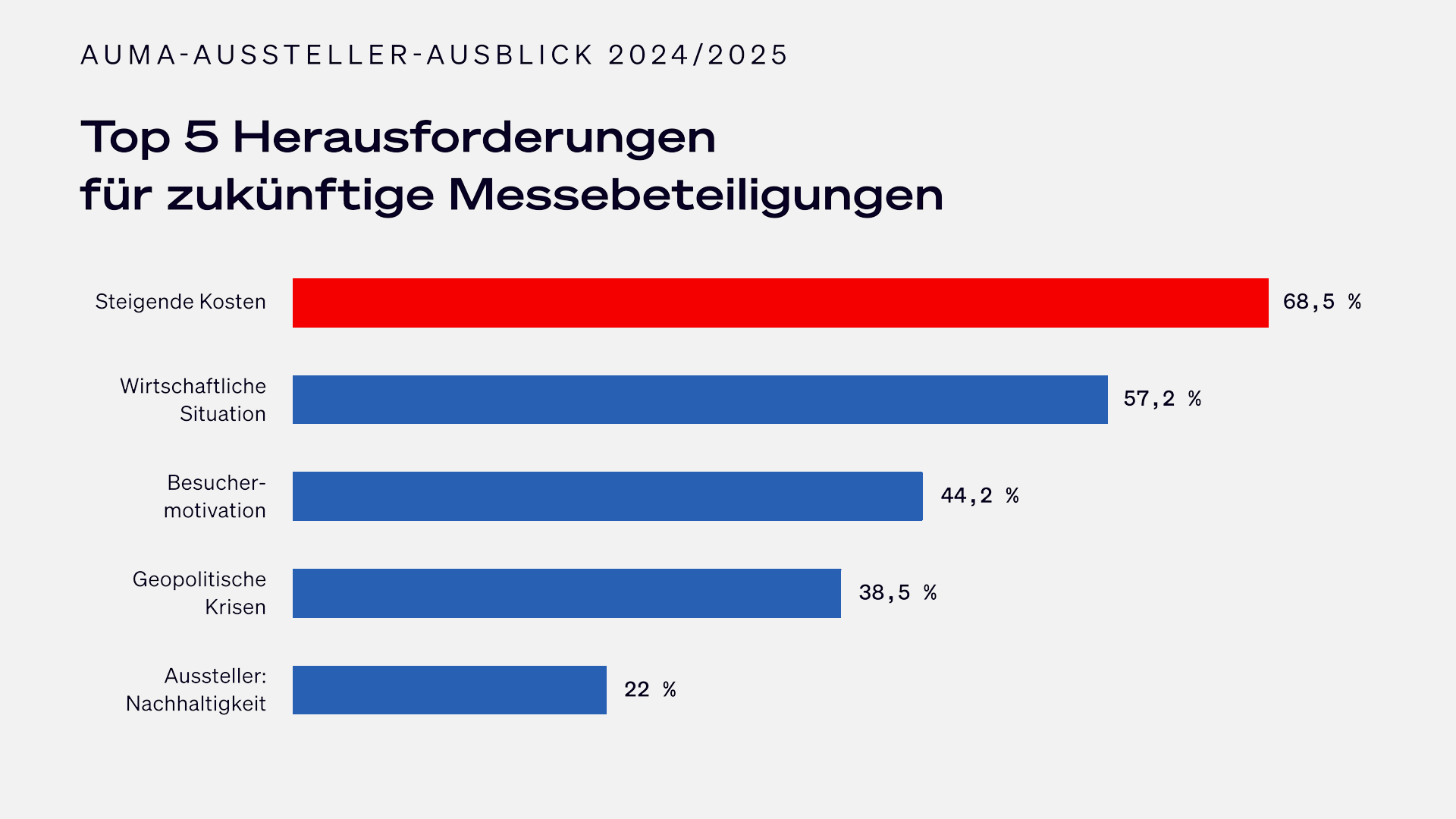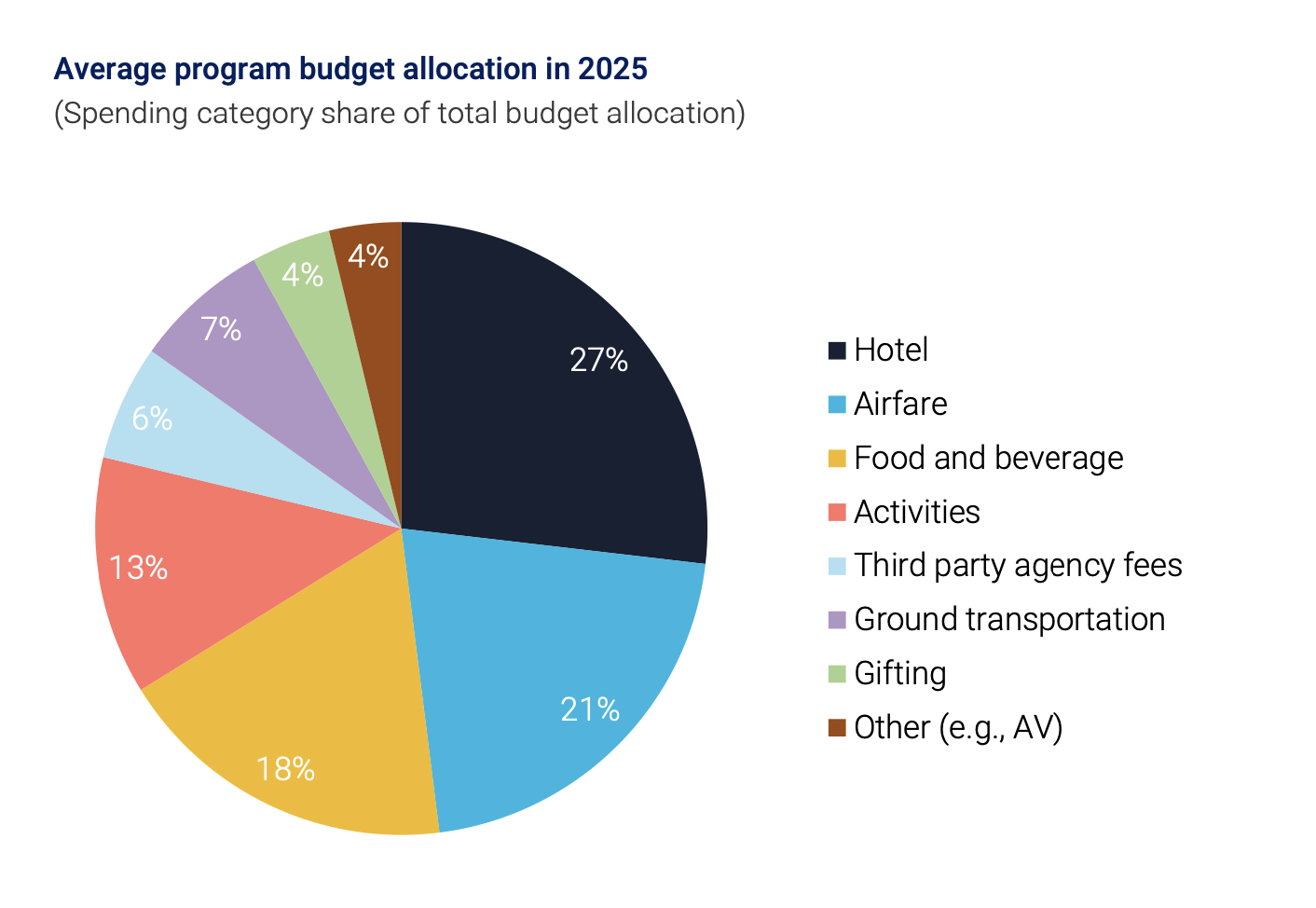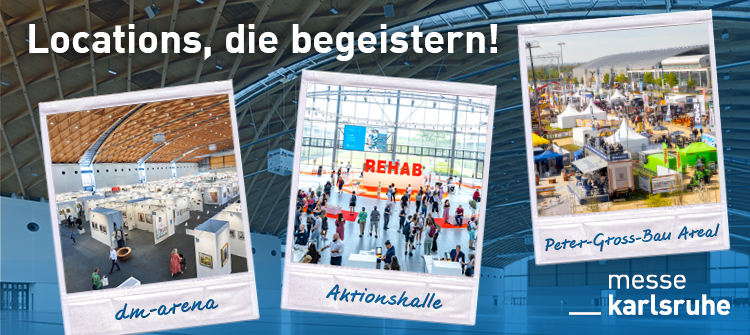
Industry reports
Rising costs at a glance

Source: Trade fair insights AUMA Exhibitor Outlook 2024/2025 Survey in October/November 2023, n=400 companies
Picture: AUMA
The MICE industry associations have recently published their reports with expectations for the coming year. In the reports, rising costs emerge as a particular challenge. Taking stock of the situation.
In the summer, DHBW Ravensburg published the results of a panel research project led by Prof Dr Bernd Radtke involving around 1,800 event agencies. The aim of his research is to analyse current trends that move event agencies. And it shows: The current hot topic is cost increases in the realisation of events, which affect all trades, personnel costs, rents etc. across the board. Within the space of a year, costs have slipped from 9th place to the top position. The topic appears to be gaining in relevance for the industry.
The 2025 Planner Sourcing Report from software company Cvent was only published in mid-October. According to the report, 67 per cent of all planners expect costs to rise next year. 61 per cent expect budget increases. In contrast, 93 per cent of planners are prepared to adjust their budget in order to book desired hotels and venues. Also exciting in this respect: Almost half of event planners in Germany book luxury hotels, which indicates a preference for the high-end market. "The latest findings from our 2025 Europe Edition show a wave of optimism among planners here in Germany; 97% are positive about the state of the industry," comments Markus Laibacher, Regional Sales Director at Cvent, on the results.
Budgeting in 2025
The Bundesverband für Industriekommunikation (BVIK) is also optimistic about budgeting in the coming year. According to the September survey on B2B marketing budgets, over 70 per cent of respondents expect their budgets to remain the same or even increase in the coming year. Only 18 per cent believe that they will have to make do with a smaller budget. BVIK also asked which type of event would be used most frequently. Trade fairs and (specialist) congresses came out on top by some distance. This shows a general willingness to accept cost increases for MICE events. For René Tumler, Managing Director of the European Association of Event Centres (EVVC), one thing is clear: "Events, and congresses and conferences in particular, are an important factor in economic and social life and must be allowed to incur costs."

Photo: Christof Mattes
"Events, and in particular congresses and conferences, are an important factor in economic and social life and must be allowed to generate costs."
René Tumler, Managing Director of the EVVC
Costs at the top
In the AUMA Organiser Outlook 2024 - 2025 and the AUMA Exhibitor Outlook 2024 - 2025, costs are at the top of the list of challenges. The crux of the matter for exhibitors is that they cannot influence many costs. For example, accommodation, mobility and energy. The outlook also shows another perspective: trade fair visitors are also becoming more cost-conscious. At the same time, it is becoming increasingly important for visitors to experience something during their trade fair visit. In other words, it is yet another challenge to meet increased requirements in the face of cost pressure. The Meeting and Event Barometer also forecasts a general increase in budgets of just under 20 per cent from 2023 to 2024, compared to an average of just under 25 per cent from 2022 to 2023. Inflation and increased costs are generally perceived as a burden by providers and event organisers from Germany, Europe and the rest of the world. For organisers from Germany and Europe, the costs appear to be roughly the same. For organisers from the rest of the world, the costs are much higher.
Average conference costs increase
The Global Business Traveler Association also sees similar developments. The average meeting costs per participant are expected to rise to USD 162 in 2024, which corresponds to an increase of 4.5 per cent compared to 2023. A further increase to around USD 169 is forecast for 2025, which corresponds to an additional increase of 4.3 per cent. This trend reflects the continued growth of the industry and the increasing demand for larger and more sophisticated face-to-face events. According to the GBTA, conference costs per attendee per day were still on the decline in the previous year. This is said to be due to a shift in the types of meetings. Many companies have opted for smaller, more business-orientated meetings, often without costly incentive components. This focus on cost control, including choosing more affordable venues and destinations, helped to offset rising prices for accommodation and catering. The Verband Deutsches Reisemanagement e.V. can provide interesting insights in its VDR Business Travel Analysis 2024. Here, too, costs have risen disproportionately compared to the travel volume from 2022 to 2024. Business travellers are travelling longer on average across all company sizes. 77% of all business travellers planned MICE trips in 2022. Overall, however, the travel volume remains below 2019.
Rising costs - higher demands
In October, the Incentive Travel Index 2024 was presented at IMEX America in Las Vegas. Here, too, rising costs are seen as a particular challenge. Higher expenditure per participant is expected. At the same time, price increases must also go hand in hand with higher quality standards. Only 30 per cent expect significant budget adjustments in line with inflation. Interestingly, suppliers are more positive about the next two years than buyers.

The Incentive Travel Index (ITI) from the Incentive Research Foundation (IRF) and the Society for Incentive Travel Excellence (SITE) shows the areas in which costs are incurred and what proportion they account for. Image: ITI
The Incentive Travel Index also shows that it is not only Europe that is struggling with extreme price increases. In the Asia-Pacific region (APAC), hotels and air fares take up proportionately more budget than in Europe and North America. Higher costs are also leading to structural changes. After analysing data in Belgium and the Netherlands, the ticketing platform Eventix found that the price surge for concert and festival tickets is leading to a change in the target group. According to the study, the average age of festival-goers has risen from 26 to 31. Clubs, on the other hand, can keep their audience stable between 18 and 26. Eventix blames this on increased ticket costs. Dennis Behlau, Country Manager Eventix Germany, says: "Although this data analysis originates from the Benelux region, we see similarities with our insights in the German market. Discussions with event organisers across Germany indicate that similar trends are also occurring here. We plan to conduct further analyses in the future."
The DMC's perspective
Global DMC Partners, a network of independent destination management companies, also highlights the challenges of rising costs in the results of its Q3 2024 Meetings & Events Survey. The majority of planners surveyed stated that costs in various areas have risen by an average of 10 to 30 per cent compared to two years ago. Significant cost increases were observed particularly in the categories of hotels/event space, food and beverage, air tickets and ground transport, which is in line with the GBTA's findings..
Tips for saving costs
What tips do event professionals have for greater cost efficiency? When it comes to travel planning, Inge Pirner, Vice President of the German Travel Management Association (VDR), recommends: "In order to keep costs low, it is advisable to take a holistic view of logistics and transport. When organising an event, it should therefore be considered in advance whether the destination is logistically well connected and accessible - the better the arrival and departure to the destination can be implemented, the more costs can be saved."

Photo: VDR
"To keep costs low, a holistic approach to logistics and transport is recommended."
Inge Pirner, VDR Vice President
Erin Leonard, Founder and CEO of Erin Leonard Events, advises in the MPI online magazine The Meeting Professional to allow 10 to 15 per cent of the budget for last-minute additions. In some cases, buying is more worthwhile than renting or bundling orders with a supplier to get better conditions. Cvent also suggests the option of flexible pricing, i.e. a tiered pricing system. This would allow, for example, packages to be put together that grant free or premium access. The high-price tickets offer full access to all content as well as additional extras. René Tumler from the EVVC also sees sustainability as a way to achieve cost efficiency: "Measures that are already beneficial in terms of sustainability, such as the repeated use or reuse and upcycling of stages or decorations, can make a contribution. Another important factor can be the consideration of sustainable practices that can save costs in the long term, such as digital materials instead of printed handouts and other conference documents." It looks like costs will continue to rise across all areas of events in the coming year. However, event planners do not seem to be left alone on average. The prospect of rising budgets from BVIK confirms the importance of the industry.

